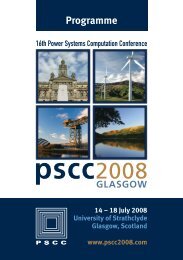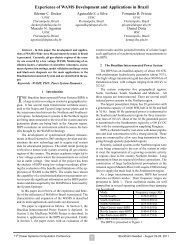Excitation Control System Design of Superconducting ... - PSCC
Excitation Control System Design of Superconducting ... - PSCC
Excitation Control System Design of Superconducting ... - PSCC
Create successful ePaper yourself
Turn your PDF publications into a flip-book with our unique Google optimized e-Paper software.
2 SCG WITH HIGH RESPONSE EXCITATION<br />
A typical structure <strong>of</strong> SCG is shown in Fig. 1. SCG<br />
can produce very high magnetic field by its<br />
superconducting field winding cooled in the cryogen<br />
such as liquid helium, which can not be realized by the<br />
conventional generator. Multi-cylindrical structure<br />
which consists <strong>of</strong> field winding, thermal radiation shield<br />
and room temperature damper is adopted in the extreme<br />
cold region. Since generated magnetic field is large<br />
enough that it is not necessary to use magnetic iron to<br />
enhance magnetic flux; instead, air-core geometry can<br />
be used; SCG can have stator windings with the<br />
“air-gap” type, which leads to the advantage <strong>of</strong> avoiding<br />
flux saturation and low synchronous reactance.<br />
Magnetic shield is installed outside for confining flux in<br />
the machine.<br />
Figure 1: Structure <strong>of</strong> SCG<br />
The equivalent circuit <strong>of</strong> SCG with high response<br />
excitation can be considered as that <strong>of</strong> the conventional<br />
generator. Contrary to SCG with low response<br />
excitation, a thermal radiation shield <strong>of</strong> SCG with high<br />
response excitation has no damping effect; it can be<br />
considered that SCG with high response excitation<br />
seems to have only one damping winding in each axis<br />
equivalent circuit, equivalent to amortisseur winding in<br />
the conventional generator.<br />
3 SMES EFFECT<br />
3.1 Concept<br />
SCG with high response excitation enables the rapid<br />
change <strong>of</strong> field current; the excitation power becomes<br />
large and changes rapidly enough to affect the<br />
conditions <strong>of</strong> power system in self-excited operation <strong>of</strong><br />
the generator. The simplified model <strong>of</strong> SCG with high<br />
response self-excitation is depicted in Fig. 2. The field<br />
winding is connected to SCG bus through the AC-DC<br />
converter. Since the field winding is made <strong>of</strong><br />
superconductors, the field winding coupling with the<br />
converter can be considered as SMES and its effect is<br />
Pm e<br />
SCG<br />
Field<br />
Winding<br />
P<br />
High Capacity<br />
Vt<br />
Power<br />
<strong>System</strong><br />
AC-DC<br />
Converter<br />
<strong>Superconducting</strong> Magnetic Energy Storage<br />
Figure 2: SCG with high response excitation in self-excitation<br />
mode<br />
thus called “SMES effect”.<br />
The excitation power in SMES effect can be<br />
evaluated by (1), which depends on some machine<br />
parameters. It should be noted that the excitation power<br />
<strong>of</strong> the SCG is smaller than that <strong>of</strong> the conventional<br />
generator due to the very small resistance <strong>of</strong><br />
superconducting field winding.<br />
e f eq1<br />
Pf<br />
= v f i f =<br />
(1)<br />
Tdo<br />
′ ω0<br />
( X d − X d′<br />
)<br />
where vf, if, and ef are the applied voltage at rotor circuit,<br />
excitation current and excitation voltage, respectively.<br />
eq1 is the generator internal voltage.<br />
SCG<br />
Pe<br />
(Pex,Qex)<br />
Vt<br />
Power<br />
<strong>System</strong><br />
Figure 3: Equivalent model for SCG with high response<br />
excitation considering SMES effect<br />
From the simplified model <strong>of</strong> SCG in self-excitation<br />
mode in Fig. 2, the excitation system including the<br />
AC-DC converter can be considered as a nonlinear load.<br />
Active and reactive powers flowing into excitation<br />
system are assumed as Pex and Qex, respectively; hence,<br />
the equivalent model for SCG with high response<br />
excitation can be obtained as shown in Fig. 3. Without<br />
any loss in transfer power, active power Pex is the same<br />
as the excitation power <strong>of</strong> SCG; reactive power Qex can<br />
be adjusted by self-commutated type converter for<br />
supporting the generator terminal voltage.<br />
3.2 Consideration <strong>of</strong> SMES Effect in Power <strong>System</strong><br />
According to the assumption <strong>of</strong> SMES effect as a<br />
nonlinear load in the power system, the relationship<br />
between current flowing into excitation system and bus<br />
voltage at the SCG with high response excitation in<br />
self-excitation mode can be obtained by (2) in d and q<br />
axes with consideration <strong>of</strong> Pex and Qex.<br />
⎡I<br />
⎢<br />
⎣<br />
I<br />
exD<br />
exQ<br />
⎤ 1 ⎡ Pex<br />
⎥ = ⋅<br />
2 ⎢<br />
⎦ V ⎣−<br />
Q<br />
t<br />
ex<br />
Q<br />
P<br />
ex<br />
ex<br />
⎤⎡V<br />
⎥⎢<br />
⎦⎣<br />
V<br />
D<br />
Q<br />
⎤<br />
⎥<br />
⎦<br />
(2)<br />
where VD and VQ are d and q-axes terminal voltage<br />
components <strong>of</strong> SCG bus, respectively.<br />
Assuming that IG is the vector <strong>of</strong> currents through<br />
generators, Iex is the vector <strong>of</strong> currents <strong>of</strong> all nonlinear<br />
loads connecting to generator buses, which includes the<br />
SMES effect, VG is the vector <strong>of</strong> generator bus voltages,<br />
VL is the vector <strong>of</strong> load bus voltages, Y is the admittance<br />
bus matrix which consists <strong>of</strong> four sub-matrices YGG, YGL,<br />
YLG, and YLL, the relationship <strong>of</strong> currents and bus<br />
voltages <strong>of</strong> power system in a matrix-form is given in<br />
(3).<br />
⎡I G − Iex<br />
⎤ ⎡VG<br />
⎤ ⎡YGG<br />
⎢ ⎥ = Y ⎢ ⎥ = ⎢<br />
⎣ 0 ⎦ ⎣VL<br />
⎦ ⎣YLG<br />
YGL<br />
⎤⎡VG<br />
⎤<br />
Y<br />
⎥⎢<br />
⎥<br />
LL ⎦⎣VL<br />
⎦<br />
15th <strong>PSCC</strong>, Liege, 22-26 August 2005 Session 28, Paper 1, Page 2<br />
(3)




